Make hay while the sun shines
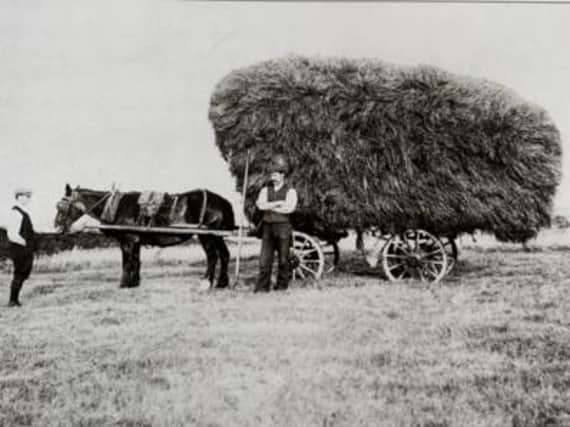

he making of hay, for the feeding of livestock during the winter months, was the most important summer job for the farmer. Warm, sunny weather was vital to the making of good hay.
If the weather was favourable hay time would begin in the middle of June in the low-lying village farms.
Advertisement
Hide AdAdvertisement
Hide AdIn the dales, hay time would not commence until the middle of July. Hay time provided the men of the village with extra money. Men and young lads who had jobs near the village would go to local farms in the evenings and weekends to help. Most local farms employed migrant farm workers from Ireland, who would come to England for the summer months. After the Second World War, the average rate for an Irish farm worker was £40 per month.
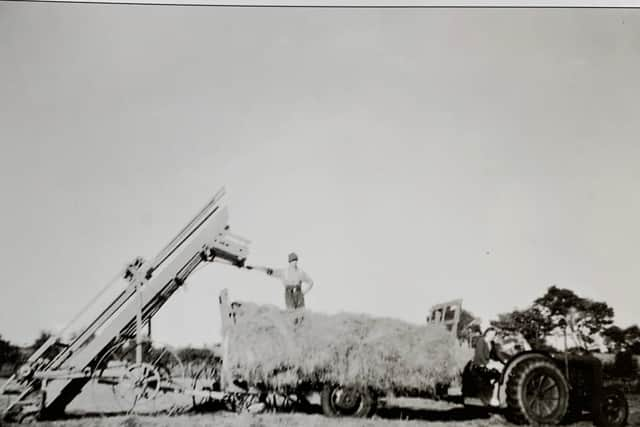

However, by 1953 this had risen to £53. There were no set hours of work and the working day would last until the job was complete.
The long school holidays in the summer months were originally designed so the schoolchildren could help with haymaking and harvest.
Albert Wilson, who was a young boy in 1946, attended Lower Tatham School.
Advertisement
Hide AdAdvertisement
Hide AdHe recalls being summoned home to Park House Farm, near Wennington, by his father, Clifford Wilson, hanging a white sheet from a bedroom window.
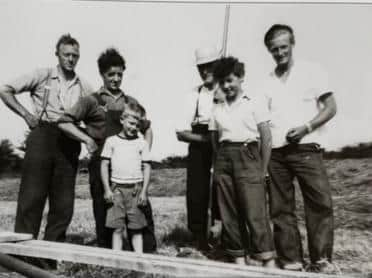

This signal was also used by Harry Gorst at Bellhurst Farm to instruct his brother, Joe Gorst, that the hay was ready for baling. The first stage in the hay making cycle was the manuring of the ground; this would begin in late autumn and continue through most of the winter months, weather permitting. The manure from the cattle, which had been kept inside the previous winter, would have been put on the farm midden.
This was then carted out to the meadows in the farm muck cart and placed in heaps using the muck drag, which was a long handled for with its four teeth bent at right angles.
The heaps were placed seven strides apart and seven strides between the rows. The heaps would be left for some time for the rain and frosts to do their work. The manure would then be scaled out using the muck fork. Young local men would scale muck for local farmers at the weekend to earn extra money. The average rate in the 1940s was one old penny per heap. After a further period of weathering, the field would then be chain harrowed to break up the manure into small pieces. The final task would be stone pick the meadow. The purpose of this was to ensure that no stones could damage the mowing machine or scythes.
Advertisement
Hide AdAdvertisement
Hide AdOften, sheep would be lambed in the meadows before the grass was allowed to grow into meadow grass.
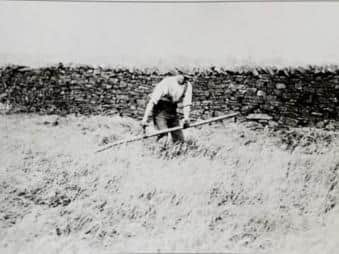

The mowing of the grass began very early in the morning before the sun attained its full power, making life easier for the horse or horses as pulling a mowing machine was hard work.
Horse drawn mowing machines appear to have been in common use from the late 19th century onwards.
A local Wray joiner and wheelwright’s account book lists repairs to mowing machines as early as 1865. However, gangs of scythe mowers were still working up to 1900. The next operation in the hay making process was the turning of the swathes. This was either achieved by hand, using a hay rake or by machine, using a horse drawn swathe-turner or side delivery rake.
Advertisement
Hide AdAdvertisement
Hide AdThe side delivery rake could turn swathes if the central part of the machine was removed. Turning the swathes enabled the underside to dry; it also exposed the ground to the drying power of the sun. After the task of turning the swathes was complete, the next day’s job was to scale out the grass using hay forks or the horse drawn scaling machine. The following day, the hay would be turned into rows known as windows. If the weather was very hot, the turnings would just need to be pulled together into plats. Some farmers would keep going through the hay with the scaler until the hay was ready for carting. If the weather was very warm, it would take about four days to turn grass into hay. However, in wet summers hay making was a difficult task and the hay could be out in the fields for several weeks. If rain was likely, the hay had to be put into rows and then made into foot-cocks or the larger jocky-cocks. These were conical in shape, enabling the rainwater to run off so the hay and ground dried out quickly once the sun came out. When the threat of rain had passed, the hay had to be scaled out again, following the same procedure outlined above. The summer of 1946 is remembered by several local farmers as being a very poor year for hay making. There was one fine week at the beginning of July. However, after this the weather deteriorated and some local farms did not get their hay in the barns until October. If the hay was of poor quality, as in the summer of 1946, treacle was mixed in with the hay to make it more palatable to the cattle.
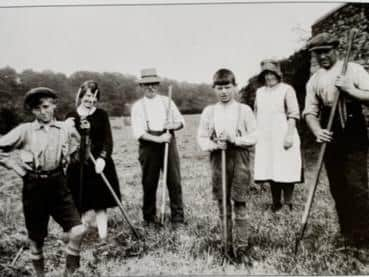

Various methods were used to transport the hay from fields into the barn or to the haystack.
These included: horse and cart, the sweeping method, using an elevator machine or using a pike bogie.
The most common method was the horse and cart, The cart would be fitted with shelvings, which fitted around the cart rim to increase its capacity. One of the most important jobs in this process was that of the loader. The hay was put into large rows known as plats and then forked up to the loader, who would stand inside the cart. The loader would wrap the hay into a ball and then place and press it into its allocated place in the cart. A skilled loader was held in high regard among local farmers.
Advertisement
Hide AdAdvertisement
Hide AdWhen the cart was loaded, ropes were used to secure the hay in place. The loader then slid down the hay to the ground. He or she would then remove any loose bits of hay with a rake before the horses pulled the cart to the hay barn or stack.
Although the traditional horse and cart method was the most popular, other quicker methods were often used to transport the hay to the barn. The sweeping method used two horses, working either side of a plat, to pull a box-like machine, which collected the hay. It was then pulled to the barn, the hay tipped out and forked up through the forking hole. Later, tractor sweeps were used with long wooden teeth. When full, the sweep would be lifted off the ground by the tractor hydraulics and taken to the barn. Another system used was the elevator machine, which was pulled behind the trailer. This machine picked up the hay then deposited it onto the tailer.
A few farmers in the local area made pikes. These were conical stacks of hay about six feet high, constructed so that water could easily run off them. These could be left out for a couple of weeks. When ready for the barn, these were often harvested using a pike bogie, which was a trailer with a hinged portion at the back. At the front was a small winch. A chain was placed around the pike. The handled turned, pulling the pike on to the tractor-trailer, which was then transported to the barn. When all the hay was harvested, the field would be raked to collect any bits of hay left. In earlier times, this would be undertaken by hand. Later, horse drawn rakes were used. An improvement on the hand rake was the rover; a hand-pulled rake about four feet wide with metal teeth. Once the hay arrived at the farm barn, using one of the methods outlined above, it could enter the barn either through the barn doors or through the forking hole. If using the barn doors, the horse would back the cart through its big barn doors and the hay unloaded either side of the cart. If using the forking hole, the hay entered the barn through a small door high up on the barn wall. Once inside the barn, the hay was spread around and well trodden down in the process known as mewing. Hay making became easier with the introduction of tractors. The tractor-pulled baling machine , introduced in the 1950s, picked up the hay from the plats. This made the loading of carts, forking up and sweeping redundant. However, despite technological advances, hay making was still dependent on good weather.
Comment Guidelines
National World encourages reader discussion on our stories. User feedback, insights and back-and-forth exchanges add a rich layer of context to reporting. Please review our Community Guidelines before commenting.